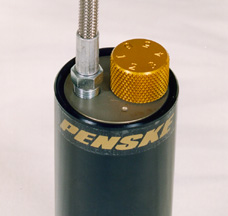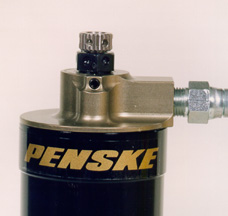ORDERS:
704-799-2192
![]()
BIKE SPECIFIC
PARTS PAGES
FOR NEW
'03-'22 Models
(Grom, Monkey
Z125, RC390,
R3, R1, R6,
ZX-10, ZX6
CBR's, GSX-R's
& more)
![]()
"VIC" Repeat
Customer Discount
Program
TOP SELLERS

Ohlins Shocks,
Forks, & Dampers

Antigravity
Superlight
Lithium Batteries
PRODUCT CATEGORIES
Air Filters
Engine Parts
Exhaust
Fairing Stay
Head Set
Communications
Helmets
Mirrors / Mirror Block Off Plates
Race Stands
Radar Detectors
Radiator Hose Kits
Tank Traction Pads / Stomp Grip
Throttle Lock / Cruise Control
Tire Pressure Monitoring (TPMS)
Windscreens
Zombie Target
NecksGen
"VIC" Repeat
Customer Discount
Program

Compression Adjuster Options
8100 Series Compression Adjuster
 From
Formula Vee to Indy Car, the 8100 Series adjuster offers a wide range of compression
adjustment for the serious racer. The method in which the PENSKE 8100 adjusts compression
forces is simple. When the damper is put into a compression condition, the fluid being
displaced by the shaft entering the body must pass through the compression adjuster drum
and the selected orifice located in the remote reservoir. As the knob is rotated, a drum
inside the compression adjuster is rotated, aligning the chosen orifice within the direct
flow of oil into the remote reservoir. The adjustment knob is numbered, from one to six.
By clicking to the number one position, the adjuster is set at full soft (utilizing the
largest hole in the compression adjuster drum). The number six position on the knob
denotes a full hard setting (oil flow is greatly restricted). This method of adjusting
compression damping is ideal for most forms of racing, especially those having higher
shaft speeds and displacements. The redesigned orifices make every adjustment have a
noticeable "feel" and have increased the range of adjustment. At higher shaft
velocities, oil passes through the orifice in the compression adjuster drum and gets a
point of "packing-up". Instead of packing-up and increasing the damping force, a
valve in the compression adjuster housing allows for the oil to bleed off, making for more
linear force curves.
From
Formula Vee to Indy Car, the 8100 Series adjuster offers a wide range of compression
adjustment for the serious racer. The method in which the PENSKE 8100 adjusts compression
forces is simple. When the damper is put into a compression condition, the fluid being
displaced by the shaft entering the body must pass through the compression adjuster drum
and the selected orifice located in the remote reservoir. As the knob is rotated, a drum
inside the compression adjuster is rotated, aligning the chosen orifice within the direct
flow of oil into the remote reservoir. The adjustment knob is numbered, from one to six.
By clicking to the number one position, the adjuster is set at full soft (utilizing the
largest hole in the compression adjuster drum). The number six position on the knob
denotes a full hard setting (oil flow is greatly restricted). This method of adjusting
compression damping is ideal for most forms of racing, especially those having higher
shaft speeds and displacements. The redesigned orifices make every adjustment have a
noticeable "feel" and have increased the range of adjustment. At higher shaft
velocities, oil passes through the orifice in the compression adjuster drum and gets a
point of "packing-up". Instead of packing-up and increasing the damping force, a
valve in the compression adjuster housing allows for the oil to bleed off, making for more
linear force curves.
8760 Series Compression Adjuster
 The 8760 Series compression adjuster is the ultimate tuning tool for
the professional race team. The 8760 Series adjuster offers separate adjusters for both
high and low speed shaft movements. The high speed adjuster controls larger track
inconsistencies that may disrupt the car, while the low speed adjuster controls slow shaft
movements such as body roll, corner entry and exit.
The 8760 Series compression adjuster is the ultimate tuning tool for
the professional race team. The 8760 Series adjuster offers separate adjusters for both
high and low speed shaft movements. The high speed adjuster controls larger track
inconsistencies that may disrupt the car, while the low speed adjuster controls slow shaft
movements such as body roll, corner entry and exit.
When the damper is being compressed, the fluid is being displaced into the adjuster and passes through a piston in the adjuster. When adjusting the high speed, the secondary valve shims are being preloaded, giving you different compression forces. The low speed adjustment meters the fluid and bypasses the piston in the adjuster, providing an adjustable combination of bleed and shim controlled damping.
In effect, the combination of a low speed and high speed adjustments will offer the ultimate tuning combination.
<- BACK
